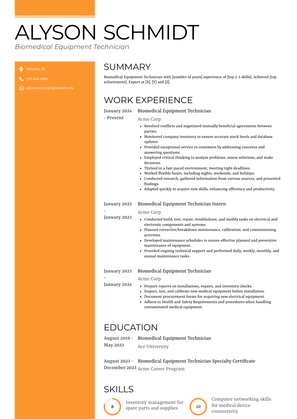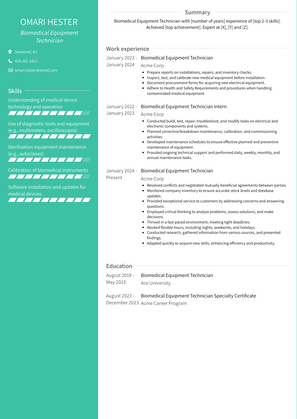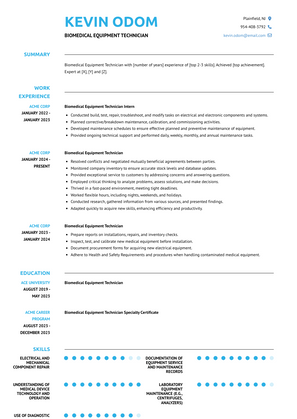Biomedical Equipment Technician Resume Examples and Templates
This page provides you with Biomedical Equipment Technician resume samples to use to create your own resume with our easy-to-use resume builder. Below you'll find our how-to section that will guide you through each section of a Biomedical Equipment Technician resume.



What do Hiring Managers look for in a Biomedical Equipment Technician Resume
- Technical Proficiency: Proficiency in troubleshooting, repairing, and maintaining biomedical equipment.
- Analytical Skills: Ability to diagnose equipment malfunctions and perform effective repairs.
- Attention to Detail: Meticulous in following equipment maintenance procedures and documentation.
- Adaptability: Flexibility to work with a variety of medical devices and technologies.
- Communication: Strong interpersonal skills for collaborating with healthcare professionals and equipment vendors.
How to Write a Biomedical Equipment Technician Resume?
To write a professional Biomedical Equipment Technician resume, follow these steps:
- Select the right Biomedical Equipment Technician resume template.
- Write a professional summary at the top explaining your Biomedical Equipment Technician’s experience and achievements.
- Follow the STAR method while writing your Biomedical Equipment Technician resume’s work experience. Show what you were responsible for and what you achieved as a Biomedical Equipment Technician.
- List your top Biomedical Equipment Technician skills in a separate skills section.
How to Write Your Biomedical Equipment Technician Resume Header?
Write the perfect Biomedical Equipment Technician resume header by:
- Adding your full name at the top of the header.
- Add a photo to your resume if you are applying for jobs outside of the US. For applying to jobs within the US, avoid adding photo to your resume header.
- Add your current Biomedical Equipment Technician position to the header to show relevance.
- Add your current city, your phone number and a professional email address.
- Finally, add a link to your portfolio to the Biomedical Equipment Technician resume header. If there’s no portfolio link to add, consider adding a link to your LinkedIn profile instead.
Bad Biomedical Equipment Technician Resume Example - Header Section
Kevin 167 Hamilton Drive Phillipsburg, NJ 08865 Marital Status: Married, email: cooldude2022@gmail.com
Good Biomedical Equipment Technician Resume Example - Header Section
Kevin Odom, Phillipsburg, NJ, Phone number: +1-555-555-5555, Link: linkedin/in/johndoe
Make sure to add a professional looking email address while writing your resume header. Let’s assume your name is John Doe - here is a formula you can use to create email addresses:
- firstnamelastname@email.com - johndoe@email.com
- firstname.lastname@email.com - john.doe@email.com
- lastname.firstname@email.com - doe.john@email.com
- f.lastname@email.com - j.doe@email.com
- l.firstname@email.com - d.john@email.com
- firstnamelastname12@email.com - johndoe12@email.com
For a Biomedical Equipment Technician email, we recommend you either go with a custom domain name (john@johndoe.com) or select a very reputed email provider (Gmail or Outlook).
How to Write a Professional Biomedical Equipment Technician Resume Summary?
Use this template to write the best Biomedical Equipment Technician resume summary: Biomedical Equipment Technician with [number of years] experience of [top 2-3 skills]. Achieved [top achievement]. Expert at [X], [Y] and [Z].
How to Write a Biomedical Equipment Technician Resume Experience Section?
Here’s how you can write a job winning Biomedical Equipment Technician resume experience section:
- Write your Biomedical Equipment Technician work experience in a reverse chronological order.
- Use bullets instead of paragraphs to explain your Biomedical Equipment Technician work experience.
- While describing your work experience focus on highlighting what you did and the impact you made (you can use numbers to describe your success as a Biomedical Equipment Technician).
- Use action verbs in your bullet points.
Biomedical Equipment Technician Resume Example
Biomedical Equipment Technician
- Resolved conflicts and negotiated mutually beneficial agreements between parties.
- Monitored company inventory to ensure accurate stock levels and database updates.
- Provided exceptional service to customers by addressing concerns and answering questions.
- Employed critical thinking to analyze problems, assess solutions, and make decisions.
- Thrived in a fast-paced environment, meeting tight deadlines.
- Worked flexible hours, including nights, weekends, and holidays.
- Conducted research, gathered information from various sources, and presented findings.
- Adapted quickly to acquire new skills, enhancing efficiency and productivity.
Biomedical Equipment Technician Resume Example
Biomedical Equipment Technician
- Prepare reports on installations, repairs, and inventory checks.
- Inspect, test, and calibrate new medical equipment before installation.
- Document procurement forms for acquiring new electrical equipment.
- Adhere to Health and Safety Requirements and procedures when handling contaminated medical equipment.
Biomedical Equipment Technician Intern Resume Example
Biomedical Equipment Technician Intern
- Conducted build, test, repair, troubleshoot, and modify tasks on electrical and electronic components and systems.
- Planned corrective/breakdown maintenance, calibration, and commissioning activities.
- Developed maintenance schedules to ensure effective planned and preventive maintenance of equipment.
- Provided ongoing technical support and performed daily, weekly, monthly, and annual maintenance tasks.
Top Biomedical Equipment Technician Resume Skills for 2023
- Biomedical equipment maintenance and repair
- Troubleshooting medical equipment issues
- Calibration of biomedical instruments
- Preventive maintenance procedures
- Equipment testing and inspection
- Safety testing and compliance
- Electrical and mechanical component repair
- Circuit board repair and soldering
- Use of diagnostic tools and equipment (e.g., multimeters, oscilloscopes)
- Understanding of medical device technology and operation
- Knowledge of medical equipment manufacturers' specifications
- Understanding of medical equipment documentation (service manuals, schematics)
- Inventory management for spare parts and supplies
- Software installation and updates for medical devices
- Computer networking skills for medical device connectivity
- Knowledge of healthcare regulations and standards (e.g., FDA, AAMI)
- Compliance with medical equipment quality standards (e.g., ISO 13485)
- Infection control procedures for medical equipment
- Radiation safety protocols for imaging equipment
- Biomedical equipment installation and setup
- Equipment commissioning and decommissioning
- Understanding of medical equipment interfaces (e.g., RS-232, USB)
- Biomedical equipment performance testing
- Calibration traceability and documentation
- Equipment recalls and safety alerts management
- User training on biomedical equipment operation and maintenance
- Documentation of equipment service and maintenance records
- Asset management for biomedical equipment
- Collaboration with healthcare staff for equipment needs assessment
- Biomedical equipment lifecycle management
- Biomedical equipment upgrade and replacement planning
- Emergency response for equipment failures
- Knowledge of medical equipment warranties and service contracts
- Environmental monitoring for medical equipment storage
- Understanding of medical equipment usage environments (e.g., OR, ICU)
- Proper lifting and moving techniques for heavy equipment
- Understanding of electrical and plumbing codes for medical equipment installation
- Familiarity with medical gas systems and regulations
- Knowledge of pneumatic and hydraulic systems in medical devices
- Patient monitoring system setup and troubleshooting
- Anesthesia machine maintenance and calibration
- Ventilator maintenance and testing
- Defibrillator and cardiac monitor maintenance
- Infusion pump maintenance and repair
- Laboratory equipment maintenance (e.g., centrifuges, analyzers)
- Diagnostic imaging equipment maintenance (e.g., X-ray machines, MRI)
- Surgical equipment maintenance (e.g., surgical lights, tables)
- Sterilization equipment maintenance (e.g., autoclaves)
- Rehabilitation equipment maintenance (e.g., wheelchairs, therapy devices)
How Long Should my Biomedical Equipment Technician Resume be?
Your Biomedical Equipment Technician resume length should be less than one or two pages maximum. Unless you have more than 25 years of experience, any resume that’s more than two pages would appear to be too long and risk getting rejected.
On an average, for Biomedical Equipment Technician, we see most resumes have a length of 2. And, that’s why we advise you to keep the resume length appropriate to not get rejected.
-
What do Hiring Managers look for in a Biomedical Equipment Technician Resume
-
How to Write Your Biomedical Equipment Technician Resume Header?
-
How to Write a Professional Biomedical Equipment Technician Resume Summary?
-
How to Write a Biomedical Equipment Technician Resume Experience Section?
-
How Long Should my Biomedical Equipment Technician Resume be?
Copyright ©2025 Workstory Inc.
